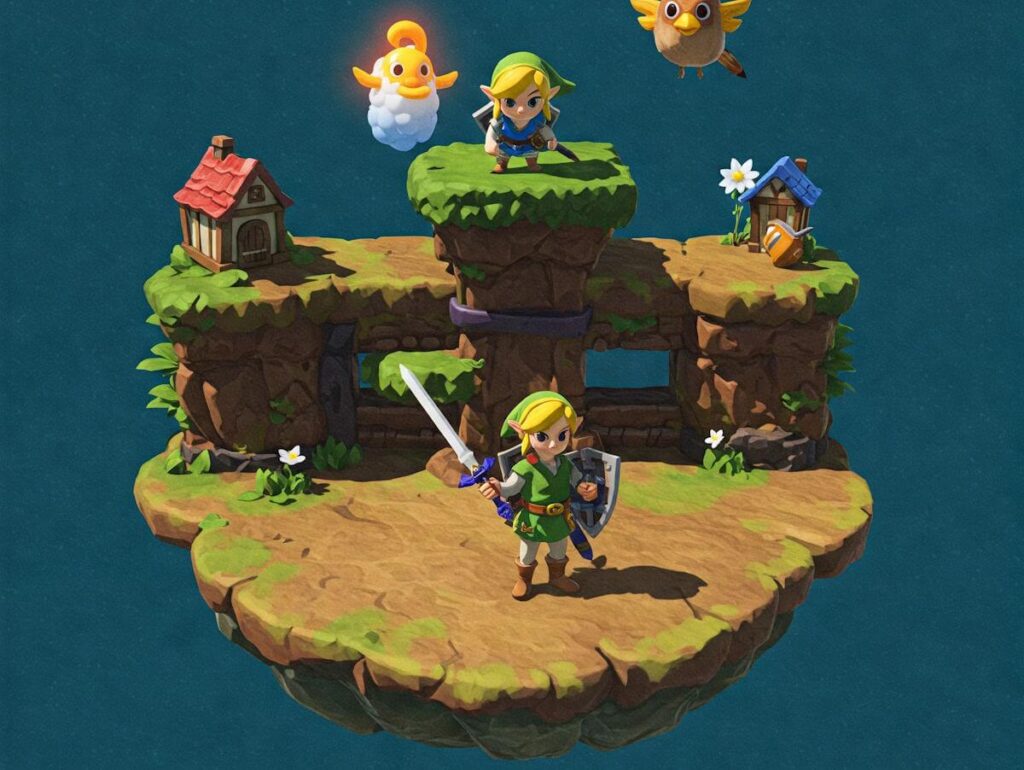Released in March 2012 by Thatgamecompany, Journey is a notable entry in the canon of indie video games, representing a significant departure from traditional mainstream titles. At a time when the gaming industry was heavily dominated by high-budget AAA games with extensive marketing campaigns, Journey emerged as a counter-narrative, highlighting the potential of smaller, independent studios to create profound and engaging experiences. This juxtaposition not only serves to illustrate the diversity of the gaming landscape but also underlines the importance of innovation within the medium.
Journey is characterized by its unique gameplay mechanics, which prioritize exploration and cooperative play over competition and conflict. Players navigate vast, breathtaking landscapes filled with ancient ruins and expansive sand dunes, embodying a robed figure on a quest to reach a distant mountain. This gameplay is complemented by a stunning visual aesthetic that emphasizes both beauty and simplicity, allowing players to immerse themselves fully in the environment. The artistic approach of Journey is distinctively minimalist, combining fluid animations with a striking color palette that elicits an array of emotional responses.
Furthermore, the game’s emotional storytelling transcends traditional narrative devices, opting for an experience that is largely non-verbal. The connections forged between players, who can interact without the use of words, highlight the power of shared experiences in fostering empathy and understanding. This emotional core sets Journey apart from many contemporary titles, inviting players to not only traverse its physical landscape but also to embark on a personal journey of self-discovery and connection. As such, Journey stands as a seminal work within the indie game sector, illustrating the potency of artful design and meaningful interaction in the realm of digital entertainment.
The Artistic Aesthetic of Journey
Released by Thatgamecompany, Journey is not only a video game but also an artistic masterpiece that encapsulates the fusion of visual art and interactive storytelling. At the heart of Journey lies its remarkable visual style, characterized by breathtaking landscapes that range from expansive deserts to serene snowy mountains. Each environment is meticulously crafted, reflecting a harmonious balance between the vastness of nature and the intimacy of the player’s journey. This attention to detail in the game’s aesthetic plays a crucial role in immersing players in an otherworldly experience, encouraging exploration and emotional engagement.
The character designs within Journey are equally minimalist yet profoundly impactful. The protagonist, a robed figure, is devoid of facial features, inviting players to project their emotions and thoughts onto the character. This minimalist approach allows for a universal connection, emphasizing the game’s themes of loneliness and companionship. The use of soft, flowing animations contributes to a fluid gameplay experience, where interactions with the environment and other players feel organic and uplifting.
Furthermore, the artistic direction of Journey is intricately woven with its emotional undertones. As players traverse the landscapes, the changes in color palettes and environmental elements serve to mirror the protagonist’s emotional state. Lush warm tones symbolize hope and joy, while cooler shades resonate with feelings of despair and solitude. This dynamic play of color not only enriches the visual narrative but also enhances the player’s emotional resonance with the journey itself. Through its innovative graphics and compelling art direction, Journey transcends the conventional boundaries of gaming, creating an immersive atmosphere that captivates players long after they put down the controller.
Sound Design and Music in Journey
The sound design and music in the video game ‘Journey’ play a crucial role in creating an immersive experience that transcends traditional gameplay. Composed by Austin Wintory, the musical score is intricately woven into the fabric of the game’s narrative. Wintory’s innovative approach ensures that the music responds dynamically to players’ actions, enhancing emotional engagement throughout the journey. Each note and melody is carefully crafted to evoke specific feelings, mirroring the player’s exploration, triumphs, and challenges.
As players traverse the vast deserts and vibrant landscapes, the score evolves in real-time, shifting in tone and intensity based on gameplay. For instance, when encountering another player, the music swells, encouraging a sense of connection and wonder, while moments of solitude are accompanied by softer, more introspective melodies. This adaptive sound design not only complements the visual artistry but also serves as an essential storytelling device, guiding players through the emotional highs and lows of the adventure.
The seamless integration of music into the gaming experience creates a unique auditory landscape that influences how players perceive their surroundings. For example, during moments of discovery or danger, the score intensifies, aligning with the player’s heartbeat. Conversely, in serene moments, the music becomes ethereal, allowing players to reflect and absorb the atmosphere. This deliberate design fosters a profound emotional connection between the player and the game, inviting exploration and encouraging players to engage with the narrative on a deeper level.
Overall, the evocative sound design and masterful composition in ‘Journey’ exemplify how music can elevate a gaming experience beyond mere entertainment, immersing players in a world that resonates emotionally and artistically. Through Wintory’s work, ‘Journey’ stands as a testament to the power of sound in storytelling and its ability to enhance the interactive nature of the medium.
Gameplay Mechanics: A New Kind of Experience
The gameplay mechanics of ‘Journey’ represent a transformative approach in the realm of interactive experiences, particularly within the indie game sector. Unlike traditional multiplayer games that rely heavily on voice chat or text, ‘Journey’ invites players to connect in a manner that is subtle yet profound. Upon entering the game, players find themselves in a vast, visually striking desert landscape, where they can encounter other players organically, without the need for direct communication methods often employed in gaming.
This unique methodology fosters a sense of companionship that is central to ‘Journey’s’ narrative. Players cannot identify each other by usernames nor can they communicate explicitly, thus creating an ambiance of anonymity. As players traverse the expansive environments, they can interact primarily through musical chimes, gestures, and visual cues. This non-verbal communication mechanics encourage emotional connections, allowing players to form bonds through shared experiences of exploration and discovery. The absence of traditional chat systems ensures that players focus on their surroundings, enhancing the immersive artistry of the game.
Moreover, the gameplay mechanics facilitate an environment that promotes collaboration rather than competition. Players can aid each other in navigating the beautifully crafted landscapes, solving puzzles, or overcoming obstacles that require teamwork. This essential component of cooperation plays a significant role in fostering a sense of community among players, as shared achievements strengthen their connection. Each interaction, however brief, contributes to a greater narrative, amplifying the themes of companionship and human connection.
Ultimately, ‘Journey’ incorporates a revolutionary gameplay style that challenges conventional norms associated with multiplayer experiences. By encouraging players to engage emotionally rather than through dialogue, it transforms the simple act of playing into a poetic expression of unity and exploration.
Narrative and Themes in Journey
The game ‘Journey’ offers a profound exploration of human connection and the emotional landscape through its unique narrative structure and thematic depth. At its core, the narrative unfolds without the use of dialogue, creating an experience that heavily relies on visual symbolism and environmental storytelling. This deliberate choice emphasizes the themes of isolation, discovery, and the cyclical nature of life, which resonate universally across diverse audiences.
One of the central themes is isolation. Players begin their adventure alone in a vast desert, symbolizing the individual struggle that often accompanies personal journeys. This solitude is palpable, immersing players in a sense of introspection. However, as the game progresses, the potential for connection emerges. Encounters with other players, who appear as glowing figures, add depth to the narrative. These moments of interaction serve as poignant reminders of the beauty found in shared experiences, fostering a sense of community amidst the isolation that initially envelops the player.
Discovery also plays a critical role in the narrative arc of ‘Journey’. As players traverse through stunning landscapes filled with ancient ruins and majestic mountains, they uncover not just the world around them but also deeper meanings tied to their existence. Each step taken leads to new revelations, symbolizing the continuous exploration of self and the surrounding environment. The game’s design intentionally encourages curiosity, allowing players to forge their paths while reflecting on their choices.
Lastly, the cycle of life theme ties the entire experience together. The game’s progression mimics a journey through life stages, portraying growth, loss, and rebirth. The visual motifs and musical score enhance this cyclical narrative, creating an emotional landscape that encourages players to ponder their own life journeys. Overall, ‘Journey’ masterfully intertwines its narrative and themes to craft an unforgettable experience that deeply resonates with players. In summary, the game’s ability to communicate complex emotions without words elevates it to a significant artistic creation within the indie gaming world.
Critical Reception and Awards
Upon its release in March 2012, ‘Journey’ garnered widespread critical acclaim, marking a significant milestone in the indie game scene. Developed by Thatgamecompany, this artistically rich title was praised not only for its stunning visual design but also for its innovative gameplay mechanics and emotional storytelling. Critics were quick to recognize ‘Journey’ as a groundbreaking experience that expanded the boundaries of conventional gaming, setting a new standard for narrative-driven gameplay.
‘Journey’ was showered with numerous accolades, including the prestigious awards for Best Game and Best Indie Game at various ceremonies. The title received recognition from the Interactive Achievement Awards, where it claimed awards in categories such as Outstanding Innovation and Adventure Game of the Year. Such distinctions underscore its impact on the gaming industry, solidifying its reputation as a pioneer within the indie sphere.
The game’s influence extends beyond immediate accolades; it has inspired a generation of indie developers to explore emotional and artistic storytelling through gameplay. ‘Journey’ demonstrated that games could evoke deep emotional responses, leading to a surge in narrative-focused titles in the indie genre. This shift has encouraged developers to experiment with new ideas, fostering an environment where creativity thrives. The breathing landscapes and minimalist approach to multiplayer experience in ‘Journey’ have influenced various subsequent titles, encouraging a focus on player interaction and shared experience in gaming.
In conclusion, the critical reception and accolades of ‘Journey’ not only highlight its artistic achievements but also its lasting influence on the wider gaming landscape and the continued evolution of indie games. The legacy of its innovative approach continues to inspire developers and shape the future of gaming.
Cultural Impact and Legacy
Since its release in 2012, ‘Journey’ has significantly influenced both the artistic direction and design philosophy within the gaming industry. Created by thatgamecompany, this indie title defied traditional gaming conventions by offering a unique experience that prioritized emotional engagement and artistic expression. The minimalist approach combined with stunning visuals created an atmosphere that resonates deeply with players, paving the way for a new era in video game storytelling.
The game’s emphasis on exploration and interaction without the confines of competitive gameplay has encouraged other developers to experiment with similar themes. As a result, ‘Journey’ has opened avenues for a plethora of narrative-driven games that aim to evoke emotional responses rather than focus solely on mechanics. Innovations in art and design, inspired by ‘Journey,’ can be seen in various indie projects, where visual storytelling plays a pivotal role in shaping player experiences.
Moreover, ‘Journey’ has sparked important discussions regarding the emotional potential of video games. It challenges the notion that games must primarily be a source of entertainment, emphasizing their capability to foster introspection and connection among players. The collaborative gameplay experience, where players encounter anonymous allies, transforms the notion of multiplayer engagement into a shared emotional journey rather than mere competition. This unique interaction has inspired game developers to consider how they can evoke feelings of empathy and community in their creations.
The legacy of ‘Journey’ continues to inspire both players and creators. Through its profound impact on art and design, coupled with its invitation to explore shared human experiences, ‘Journey’ remains a touchstone within the indie gaming sphere. Its artistic innovation, emotional depth, and cultural significance solidify its place not only in the hearts of players but also in the annals of game design history, demonstrating how art in games can transcend mere entertainment.
Lessons for Indie Game Developers
Indie game developers seeking inspiration can glean significant insights from ‘Journey,’ a critically acclaimed title that has left an indelible mark on the gaming landscape. One of the standout features of ‘Journey’ is its exceptional art direction, which merges visual aesthetics with gameplay mechanics. Indie developers are encouraged to prioritize art direction, as the right visual elements not only create an immersive atmosphere but can also convey emotions and themes without relying heavily on dialogue. This demonstrates the power of visual storytelling, which can be employed effectively even in games with limited resources.
Narrative design is another cornerstone of ‘Journey’ that indie developers should consider. Unlike traditional narrative-driven games, ‘Journey’ employs a minimalist plot, allowing players to interpret the story through their experiences. This open-ended approach fosters emotional connections, as players share their unique journeys with one another. Indie developers are thus encouraged to experiment with non-linear storytelling that empowers players to derive meaning from their adventures. Integrating subtle cues and environmental storytelling can enhance the overall narrative depth, creating a more engaging experience.
Furthermore, player engagement is crucial in capturing the hearts of gamers. ‘Journey’ excels at encouraging cooperation between players, without a defined competitive structure. This aspect of social interaction is crucial for indie developers to consider while designing their games. Encouraging players to form connections through shared experiences can lead to memorable moments and foster a sense of community. Developers should contemplate how to implement mechanics that promote collaboration and emotional investment, reinforcing the understanding that gameplay is not solely about individual achievement but also about the bonds formed through shared experiences.
By studying these facets of ‘Journey,’ indie game developers can cultivate their unique artistic visions and create captivating narratives that resonate with players, paving the way for a more enriching gaming experience.
Conclusion: The Masterpiece of Indie Gaming
In reflecting on the significance of ‘Journey’, it is clear that this indie game stands as a remarkable exemplar of artistic expression in the gaming industry. Released in 2012, ‘Journey’ has continually captivated audiences with its unique blend of stunning visuals, emotive music, and a minimalist narrative that encourages exploration and connection. Unlike traditional games, which often emphasize competition and conflict, ‘Journey’ invites players to engage in a shared experience, fostering a sense of community and understanding through its innovative multiplayer components. Players traverse vast landscapes, encountering others in a meaningful and non-verbal manner, which reinforces the themes of companionship and empathy.
The artistry of ‘Journey’ extends beyond its aesthetic appeal; it represents an evolution in the way narratives can be delivered within the gaming medium. Through its environmental storytelling, players are encouraged to derive personal meaning from their experiences, resulting in each journey being uniquely significant to the individual. This emphasis on emotional resonance and abstract storytelling has set a new standard for indie developers, inspiring many to explore deeper themes and artistic values in their work.
Furthermore, the impact of ‘Journey’ on players and developers alike cannot be overstated. For players, the game offers a reflective experience that resonates long after the final credits roll, encouraging contemplation about life, connection, and the meaning of the journey itself. For developers, ‘Journey’ serves as an influential model, proving that creative innovation and emotional depth can lead to commercial success, thereby further legitimizing indie games in the broader market. As you consider the profound influences ‘Journey’ has had, it is essential to experience its beauty for yourself, as its ability to evoke emotion and forge connections exemplifies the pinnacle of what indie gaming can achieve.




